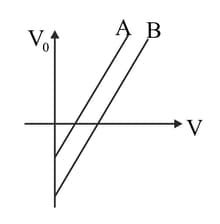Embibe Experts Solutions for Chapter: Dual Nature of Radiation and Matter, Exercise 1: Goa Board-2019
Embibe Experts Physics Solutions for Exercise - Embibe Experts Solutions for Chapter: Dual Nature of Radiation and Matter, Exercise 1: Goa Board-2019
Attempt the free practice questions on Chapter 11: Dual Nature of Radiation and Matter, Exercise 1: Goa Board-2019 with hints and solutions to strengthen your understanding. EMBIBE CHAPTER WISE PREVIOUS YEAR PAPERS FOR PHYSICS solutions are prepared by Experienced Embibe Experts.
Questions from Embibe Experts Solutions for Chapter: Dual Nature of Radiation and Matter, Exercise 1: Goa Board-2019 with Hints & Solutions

A graph of stopping potential against incident frequency for two photo sensitive metals and is shown in the figure.
Which of the two metals and has the higher threshold wavelength?
Write the expression for the maximum velocity of a photo electron, in terms of its cut off voltage .
In a photoelectric emission Stopping potential is constant. Which quantity of the incident radiation is kept constant ?
In a photoelectric emission, Maximum kinetic energy of the emitted photoelectrons is constant. In each of the case, which quantity of the incident radiation is kept constant?
Why are alkali metals most suited as photo-sensitive materials ?
An electron and a proton have the same kinetic energy which particle has the shorter de-Broglie wavelength.
An electron and a proton have the same speed. Which particle has the shorter de Broglie wavelength?
Why do bigger objects in daily life not show wave-like properties?
